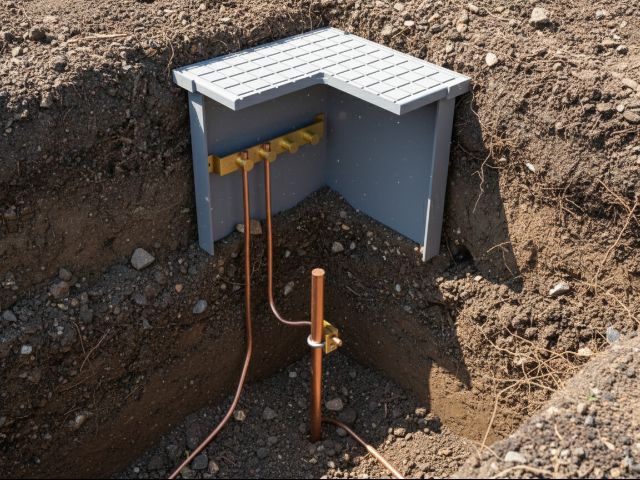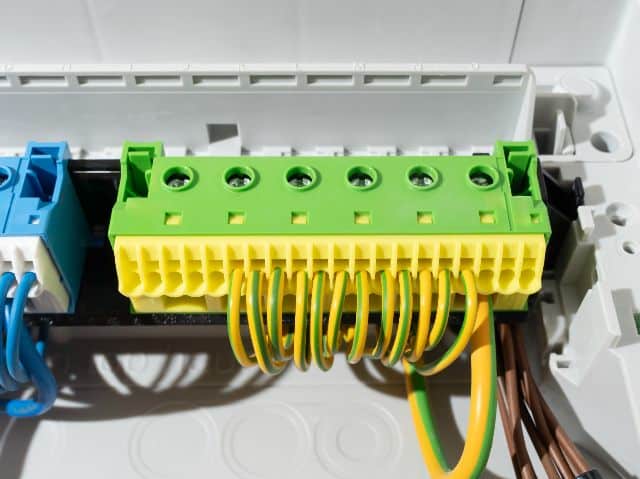Earthing (or grounding) is a direct, physical connection of an electrical installation to the ground. It consists of buried metallic electrodes (such as spikes or plates) and a conductor, usually green/yellow in color, which connects them to the metallic parts of the installation.
Its basic purpose is to provide a low-resistance path for unwanted currents, such as leakage due to faulty insulation or atmospheric discharges, to be safely diverted into the ground. In this way, current is prevented from passing through a person’s body or damaging connected equipment. In essence, it acts as a protective umbrella and is an essential and mandatory safety feature in most modern regulations.
Table of Contents
What is grounding really for? The 4 key functions
The earth connection fulfills several roles in an electrical installation, all related to the safety of people and equipment connected to the electrical installation.
Protection against electric shock
If an insulation fault places the metal casing of an appliance under voltage, the earth connection provides an alternative path of least resistance for the leakage current, preventing it from passing through the body of a person touching the equipment. In addition, it works in conjunction with devices such as the residual current circuit breaker (RCD), causing automatic disconnection of the circuit when this earth fault is detected.
Surge and lightning shield
In the face of phenomena such as lightning or transient surges, a good grounding system channels excess energy to the ground, protecting both people and household appliances. It also dissipates static electricity accumulated in large metallic structures, preventing sparks or damage to sensitive electronic equipment.
Voltage stabilization
The earth ground acts as a zero potential reference in electrical systems. Connecting metal grounds to earth ensures that they all share a common potential, a principle known as equipotentiality. This stabilizes system voltages and prevents erratic voltages, avoiding the risk of shock by simultaneously touching two metal objects that might otherwise be at different potentials.
Guaranteed protection performance
Grounding provides a return path for fault currents, which facilitates immediate tripping of fuses or circuit breakers. This guarantees the effective actuation of electrical protections, minimizing the time that equipment can remain accidentally energized.
How is grounding installed?
From burying a spike in the garden to industrial grids, the way in which the grounding is installed.
Grounding in homes and buildings
In single-family houses and residential buildings, grounding is done by burying metal electrodes (spikes or javelins) connected to each other. In modern buildings it is common to install a grounding ring in the foundation, a copper conductor that surrounds the building and improves electrical safety.
This ring or the electrodes are connected to the general switchboard through the main ground terminal, where the protective conductors (green-yellow cables) and the equipotential bonding of pipes, structures or lightning conductors also meet. Thus, any current leakage is safely diverted to the ground, protecting both people and the installation.
In older buildings without grounding, grounding rods are often added in courtyards or gardens to adapt them to current regulations.

Grounding in industrial and commercial installations
In large industrial or commercial installations, grounding requires more complex solutions to ensure safety. Buried meshes are used under electrical rooms or technical rooms, made up of metal spikes and strips that minimize ground resistance.
Large metallic structures (warehouses, towers, tanks) are connected to this grid to avoid potential build-up. In industries with special risk, such as chemical or ATEX environments, connection points are also installed to discharge static charges from tank trucks or pipelines.
Equipotential bonding is essential: all accessible metallic masses are interconnected and grounded by reliable systems, such as exothermic welding or anti-corrosion flanges, ensuring long-lasting protection.
Verification and maintenance of the earthing system
The efficiency of a grounding system is not permanent: corrosion, soil moisture or degradation of the connections can reduce its reliability. For this reason, regulations require periodic measurements of the grounding resistance, both after installation and during regular inspections or extensions.
In dwellings, it is recommended that the resistance be below 10 Ω, although the limits vary from country to country (in France, for example, up to 100 Ω is acceptable). The important thing is to ensure that the installation correctly deflects fault currents and keeps all metal masses at the same potential, guaranteeing the protection of people and equipment.
Earthing systems: TT, TN and IT
There are three main grounding schemes according to the international standard IEC 60364: TT, TN and IT.
TT system (Terra-Terra)
The TT system is the most common in Spain (present in more than 95% of installations). In this scheme, the neutral of the transformer is grounded in the network, while each dwelling or building has its own independent grounding.
In the event of a power failure, the differential detects the leakage and cuts off the current immediately, offering a high level of protection to people. Among its advantages are safety, stability against surges and the fact that it avoids transmitting faults to neighboring installations.
As disadvantages, it requires very sensitive differentials and a correct design of the grounding, which may imply a higher cost in electrodes. Even so, it is the recommended system in residential and commercial installations where safety is a priority.

TN (Ground-Neutral) system
In the TN system, the metallic masses of the installation are connected directly to the neutral of the network, which is grounded in the transformer. In this way, neutral and ground share the same reference. Depending on the configuration, it can be TN-C (combined neutral and ground), TN-S (separated at source) or TN-C-S (combined at the beginning and separated later).
When a fault occurs, the current returns through the protection conductor with low impedance, generating a high short-circuit current that trips the circuit breakers or fuses immediately. Thus, protection does not depend only on the differential.
Its advantages include constant equipotentiality and the fact that safety does not depend on the resistivity of the ground. However, it requires a very careful design: loop impedances must be calculated throughout the installation and the continuity of the PEN conductor must be guaranteed, as its breakage can be dangerous.
In the UK or Germany it is quite common, in combination with multiple earthing systems (PME).
IT system (Isolé-Terre, or Insulated Neutral)
In the IT system, the neutral of the source is isolated from ground (or connected through a high impedance), while the installation’s grounds have their own independent grounding.
In the event of a first insulation fault, the leakage current is minimal and does not trigger the protections, allowing the installation to continue operating. To control this situation, insulation monitors are installed that trigger alarms and allow the fault to be repaired before a second fault occurs. If a second fault occurs in another phase, then the conventional protections are triggered, disconnecting the installation.
Its main advantages are maximum continuity of service and a lower risk of electric shock in the first fault. However, it requires special equipment, a high quality grounding system and qualified personnel for its maintenance.
Due to its complexity, it is not used in homes, but in critical environments such as hospitals, petrochemical plants, ships, server rooms or continuous industrial processes, where a sudden power failure is not acceptable.
Comparison of grounding schemes (TT, TN and IT)
| System | Grounding | Fault protection | Advantages | Disadvantages | Most common uses |
|---|---|---|---|---|---|
| TT (Ground-Earth) | Transformer neutral to ground + independent grounding in the installation | Differential cuts off current when leakage is detected | Great protection to people, avoids transmission of faults to neighbors, stable against overvoltage. | Depends on the differential, cost of electrodes, possible potential differences between earths. | Residential and commercial |
| TN (Ground-Neutral) | Neutral and earths share the same grounding point | Short-circuit current triggers circuit breakers/fuses | Quick disconnection, constant equipotentiality, does not depend on soil resistivity | Complex design, risk of PEN breakage | Industrial installations, urban networks in UK/Germany |
| IT (Insulated neutral) | Isolated or high impedance neutral; self-grounded earths | First fault does not disconnect (alarm); second fault triggers protections | Maximum continuity of service, less risk of shock on first fault | Special equipment and qualified maintenance required, higher complexity | Hospitals, petrochemical plants, ships, data centers, critical processes. |
What happens if you don’t have grounding?
After reviewing in detail the usefulness of grounding, it is easy to imagine that the consequences of not having one can be very dangerous.
Danger of electrocution
Without grounding, the human body can become the path of leakage current when touching equipment with an insulation fault, suffering a potentially fatal shock.

Failure to disconnect protection
With non-existent or very high resistance grounding, the leakage current may be so small that the earth leakage circuit breaker does not detect it and therefore does not disconnect the circuit in time.
Damage to equipment due to overvoltages
A poor grounding system cannot effectively dissipate surges (e.g. from a nearby lightning strike), which can destroy sensitive electronics and generate electrical noise affecting other systems.
Risk of fire
Unchanneled leakage currents can generate overheating and sparks, which can cause fires if the fault persists because the protections do not act.
Lack of equipotentiality
If the grounding is degraded, equipotential bonding is lost. Different metal parts could be at different potentials, creating dangerous touch voltages even without an obvious fault.
Mandatory grounding in Europe
The obligation of grounding is included in the technical regulations of each country, almost always aligned with the international standard IEC 60364.
United Kingdom
BS 7671 and BS 7430 require grounding in all installations, with different schemes (TN-S, TN-C-S, TT, IT). All metallic parts must be connected and low resistance values maintained, using RCDs to protect against faults.
Spain
The Low Voltage Electrotechnical Regulation (REBT), in its ITC-BT-18, requires the installation of grounding in any new building or major renovation. Its purpose is to limit dangerous voltages in metallic masses and to guarantee the performance of the differential protections in case of failure.
Portugal
The RTIEBT regulation, based on the harmonized HD 384 / IEC 60364, establishes the obligation of an earth bonding in all electrical installations. It also imposes the use of earth leakage circuit breakers, following criteria practically identical to those applied in Spain.
France
The NF C 15-100 standard requires the mise à la terre in all metallic parts of the installation. Since 1969 it has been mandatory in new dwellings, with a limit of 100 Ω of ground resistance. In addition, installations must be verified by authorized bodies such as CONSUEL.
Italy
IEC 64-8 standard and Ministerial Decree 37/2008 make messa a terra mandatory in all buildings. D.P.R. 462/2001 establishes periodic inspections every 5 years in workplaces to check the efficiency of electrical installations.
Germany
DIN VDE 0100 standards regulate grounding. Since 2007, it has been mandatory to install a foundation electrode (Fundamenterder) in every new building, according to DIN 18015-1 and DIN 18014. In most parts of the country, the TN system is the most widely used.
Poland
The PN-IEC 60364 series makes uziemienie mandatory in all installations. The Prawo Budowlane law requires inspections every 5 years to check the electrical condition, including earth resistance, with particularly stringent values for lightning rod systems.
The Netherlands
NEN 1010, based on IEC 60364, governs electrical installations and requires primary equipotential bonding (hoofd-aarding) in every building. Since 1975 it has been mandatory for all new sockets to include a grounding conductor.
Czech Republic
The ČSN 33 2000 standard, equivalent to IEC 60364, regulates earthing (uzemnění). In new buildings it is required to install a foundation electrode or equivalent system, and to perform initial checks. The law also requires periodic inspections every 5 years in dwellings and more frequently in hazardous environments.
Grounding, much more than just a cable
Earthing is a simple but vital element that ensures that unwanted electricity always has a safe path. It protects people from lethal shocks and equipment from damage. As confirmed by European regulations, its mandatory nature is a universal standard to protect lives and property. Although the technical details vary, the message is clear: never do without a good earth connection. It is literally the cable that keeps us safe.


